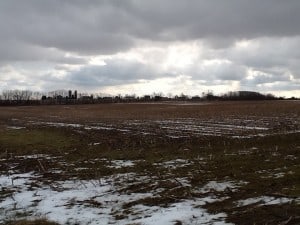Robert Swan Becomes a Farmer
By Anne Dealy, Director of Education and Public Information
Robert Swan was born in 1826, the fifth child of New York City merchant Benjamin Swan and his wife Mary. According to a family history written by Robert’s youngest brother Fred, he attended a private school in New York City and went to work at about 15 as a clerk in the dry good business. He was promoted to be a salesman and spent several years working in business in the area that is today the Financial District. Due to poor health and under the advice of a doctor, he gave up the mercantile business to become a farmer. He spent two years living and learning with John Johnston, then a farmer well known for his innovative methods.
In 1848, he began his study of farming at the age of 22, writing of his first day at the Johnston farm:
On the 31st day of July 1848 I left home via Albany to go to Mr John Johnston’s farm to learn farming of him at which place I arrived on the 2nd of August in the morning. I found Mr J at home and was much pleased with him and his family. In the course of the morning (Mr J’s son-in-law) Mr Swabi & his wife came to pay a visit at the house after a little while Mr J. Mr Swabi and myself went over the farm and on this occasion Mr J showed me how to bind wheat.
His second day proved more challenging:
Aug 3rd Thursday. I arrose [sic] this morning at 5, dressed and went down to breakfast at six. After breakfast I went to help thrash [sic] wheat in the upper barn this day we did upward of Fifty Bushels, in an hour which Mr J. said “was great work”
On the 7th he was still threshing and “dirty as a sweep.” The threshing continued until August 14th, when they started ploughing for the planting of the next year’s crop of wheat.

For several men to thresh 50 bushels of wheat in an hour, they were likely using a horse-powered machine, like Hale’s Improved Horse Powered Thresher shown here.
Robert’s description of his days over the two years that he lived at Johnston’s farm are typical of farming in this period and exhausting sounding to the modern reader. Long days of hard work dictated by the weather and the season, interspersed with time free to write letters, visit with neighbors, attend church and read the Bible, and discuss farming with Mr. Johnston and other farmers. Here is a partial list of the activities he engaged in during his two years at Johnston’s farm: fed cattle, fixed fence, helped fill ditches, planted corn, altered lambs, hoed potatoes, shot crows, sheared sheep, helped raise shed, hoed corn, cleaned harness, cultivated fallows, cut clover hay, cleaned Timothy seed, cured clover seed, sowed seed, learned to treat foot-rotted sheep and blow fly, took in corn stalks, loaded and spread manure, threshed barley, hauled in buckwheat, drove steers. He also killed a skunk found in the family well, and on another occasion repeatedly had to chase a strange bull off the farm at three in the morning.
Of course, as the son of a wealthy man who was learning from, not working for Mr. Johnston, Robert did not have to work in the same way that the paid farm laborers did. When he had problems with his foot he was laid up for a couple of days, and when his family came to town to visit he had the leisure to spend time with them. This would not be an option for a man who only got paid when he worked, as was the case with most farm laborers. Still, Robert was working hard and getting hands-on experience with one of the best farmers in the state.
Robert’s decision to take up farming was apparently not unusual. At one point in his diary he writes: “Nov 6th Monday. This morning I went over to Geneva to the post office where I found a letter from Father informing me of Mr Halsteds son Roberts intention of being a farmer.” Robert also mentions Herman Ten Eyck Foster several times in his Johnston period diary. Like Swan, Foster received several premium awards from the New York State Agricultural Society for his Seneca County farm. He too was born the son of a NYC merchant and learned farming from a Mr. Owen near Trumansburg. After establishing his farm, he married and had three children, one of whom, Pauline, married Henry A. DuPont, and was the mother of Henry F. DuPont, the founder of the Winterthur Museum in Delaware. The museum has Foster’s diary for 1842-43. Based on this document, he spent his time at the Owens’ much as Robert did at the Johnston’s.
Robert Swan’s professional choice agreed with him: “Sunday August 13th How unlike the City where all is confusion is the country where every thing seems quiet thus quieting the heart of man.” Based on his writings and the letters of his family members, the Swans were well-off, but not ostentatious or overly concerned with society and station. Robert’s father Benjamin was very wealthy and prominent, but seems to have been mostly a self-made man (if you take his son Fred’s description literally, and that may not be wise), whose primary concerns were family and religious matters. He took a genuine interest in the farm and was a life member of the New York State Agricultural Society, watching Robert’s progress in improving the farm every summer when he and his wife came for a month-long visit.
Next time we’ll look more closely at how Robert Swan managed and farmed his own land at Rose Hill.

